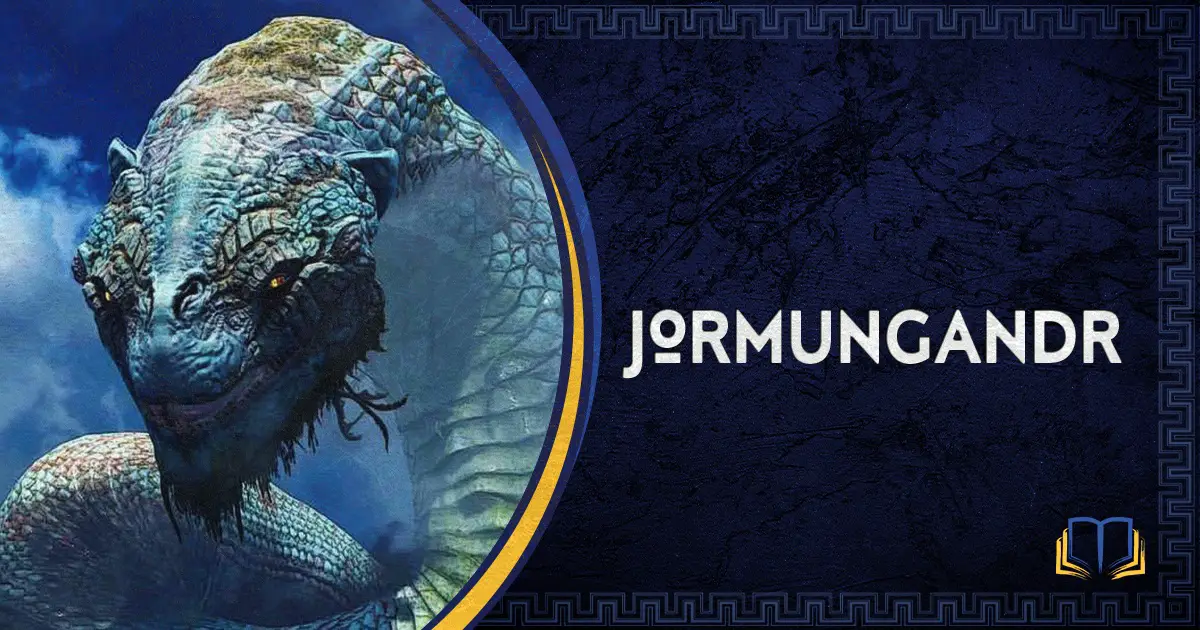Jormungandr, also known as the World Serpent and Midgard Serpent, is an important character in Norse mythology. He’s one of Loki’s children and, for reasons never made clear in surviving mythology, he’s also Thor’s sworn enemy. Jormungandr means “huge monster” in Old Norse, and is a symbol of transformation, just like identical figures in many other ancient cultures.
Thanks largely to Christian monks who recorded these myths after the rise of Christianity in Scandinavia and Iceland, we now have surviving literature that tells the story of Jormungandr, Thor, and Ragnarok. Before Christians brought writing to the Nordic people, these myths were passed down through the generations by word of mouth. So let’s take a look at the World Serpent and its role in Norse mythology.
Origins
Before the written word came to the Nordic people, brought by Christian monks, stories like the ones that feature Jormungandr were passed down orally and with the use of runes. However, these runes did not feature any writing; they featured pictures that sought to tell the central theme of a story. As such, there are remaining runes that feature Jormungandr, such as the Altuna Rune Stone, which features a depiction of Thor attempting to catch Jormungandr from a fishing boat. More on that myth below.
The bulk of the stories come to us in the form of poems, such as the Prose Edda, the Eddic poems Hymiskviða and Völuspá, and the skaldic poem Húsdrápa.
However, some scholars think it likely that the true origins of the World Serpent have a basis in ancient Egypt. In Norse mythology, Jormungandr is said to grow so large in the sea that he’s able to circle the entire world (thought to be a disc at the time) and bite onto his tail. This image of the serpent biting its own tail comes from ouroboros, which originated in Egypt but spread through Europe thanks to Greek and Roman cultures.
Jormungandr’s Family
As mentioned above, the World Serpent is one of Loki’s children. As such, he also has two siblings, Hel and Fenrir. Their mother is the giantess Angrboða. All three children were kept secret from Odin for a time. But eventually, Odin received a prophecy that Loki’s children would rise up against the gods of Asgard.
When the three siblings were still fairly young, Odin had them cast out. Hel, a female figure said to be half blue and half skin-colored, Odin banished to the underworld. Fenrir, a great wolf prophesied to kill Odin during Ragnarok, was chained to a stone on an island after attempts to tame him failed. Jormungandr was thrown into the sea in the hopes that he would drown. However, this plan backfired and Jormungandr, having plenty of room to grow in the ocean, became gigantic while staying hidden in the depths of the sea.
Appearance and Abilities
Jormungandr is depicted as a giant snake. Depictions vary, sometimes presenting him as a giant version of a common snake. Others depict him looking more like a legless dragon that lives in the sea.
At his largest, the Midgard Serpent is said to create massive tidal waves, crush mountains, and generally cause chaos with his immense size as he comes onto land. He’s also said to be able to spray poison in the air and water. When we consider that he’s large enough to circle the world and grasp his tail, it’s easy to imagine the damage he can do.
Myths: Jormungandr and Thor
Since Jormungandr is such a major figure in Norse mythology, and Thor’s greatest enemy, it’s no surprise that his major appearances all have to do with Thor. There are three major myths where Thor and the Midgard Serpent meet, all of which we’ll cover briefly below.
The Cat
In one tale, Thor is traveling with Loki and a mortal servant named Thjalfi. They come upon a stronghold of the giant Utgarda-Loki and ask to stay the night. The giant refuses to let them stay unless they can prove themselves in competitions.
Loki goes first and faces off against one of Utgarda-Loki’s men, Logi, in an eating contest. Loki devours all the meat set before him, but Logi eats the meat, bones, and even the food trough, winning the contest easily.
Thjalfi goes next, facing off against Hugi in a footrace. They race three times, and Thjalfi loses all three races.
Finally, it’s Thor’s turn, and the name of the game is a drinking contest — something which Thor is exceedingly good at. After three failed attempts at emptying his drinking horn, Thor admits defeat. The giant Utgarda-Loki makes fun of Thor, suggesting that he try to lift a nearby cat, as it would be an easier challenge for the god. Thor tries to lift the cat, but can only get one of the creature’s paws off the floor. Again, he admits defeat.
Eventually, Utgarda-Loki lets the trio stay for the night, despite the fact that they all lost the contests. The next day, the giant rides out of the stronghold with them and explains what happened the night before.
A spell tricked the trio, which is why they all lost the contests. Loki unknowingly faced off against fire, which can devour anything in its path. Thjalfi faced off against thought, which is faster than any man.
Thor, the giant tells them, was drinking from a horn that was connected to the sea, making it impossible for him to empty it. And the cat that Thor attempted to lift was actually Jormungandr, disguised by the spell. The fact that Thor lifted even one paw off the ground was impressive, given the serpent’s size. Thor is not pleased, and he raises his hammer to exact retribution for the trickery, but the giant and his stronghold vanish.
The Fishing Trip
Another tale in which Thor and Jormungandr come into conflict is based around a seemingly innocent fishing trip. The giant Hymir takes Thor fishing. After catching two whales and many fish, Hymir is ready to head back with their catch, but Thor insists on going further out and attempting to catch the World Serpent.
Hymir refuses to give Thor bait, so Thor takes it upon himself and cuts off the head of one of Hymir’s oxen. He fastens the ox head to his line and casts it into the sea. Sure enough, Jormungandr takes the bait. While Thor wrestles the serpent to the surface, Hymir begins to fear for his life. As the serpent’s massive head breaks the surface, it looks as if the boat is about to capsize. And just as Thor raises his hammer to strike the killing blow, Hymir cuts the line, and the serpent escapes.
One version of this Norse myth has Thor striking Hymir with his hammer, killing the giant. Another has Thor throwing the giant out to sea and then wading back to the shore.
Ragnarok
The last time great warrior Thor and the Midgard Serpent face-off is during the event of Ragnarok. Known as “Twilight of the Gods” or “Fate of the Gods,” Ragnarok is the prophesied series of events, including a great battle, that will result in the death of many of the gods, plunge the world into turmoil, and eventually cause a new world to rise from the ashes.
Thor’s attempt to catch and kill Jormungandr on the fishing trip is perhaps an attempt to prevent Ragnarok from happening. However, there’s no changing the fate, and, in Norse Mythology, Ragnarok is the last time we see Thor and the sea monster.
This apocalyptic battle is preceded by many tragic happenings, including the disappearance of the stars, the earth shaking so hard that trees become uprooted and mountains topple. Two wolves, Skoll and Hati (Fenrir’s sons), swallow the sun and moon, respectively.
The great wolf Fenrir breaks free of his chains while Hel releases an army for Loki to command. Jormungandr causes tidal waves and crushes mountains as he emerges from the sea, spewing poison into the air and water.
During the great battle at Vigrid, Thor and Jormungandr face off. Thor eventually kills the serpent with his hammer, but the serpent’s poison gets to Thor not long after. The god of thunder turns to see that his father, Odin, is losing ground to Fenrir. As he heads over to help his father, he only manages to walk nine paces before falling down dead.
Appearances in Popular Culture
Since Norse mythology is still popular in Western culture, it’s no surprise that Jormungandr is featured in many comics, video games, movies, and shows. Here are some of this mythological figure’s most notable appearances.
- The World Serpent appears in the God of War video game franchise. Specifically, God of War IV (2018), and presumably, God of War: Ragnarok, which is in development at the time of this writing.
- A character known as the Midgard Serpent, based on Jormungandr, appears in Marvel Comic books. The first appearance was in Marvel Tales #105 in February of 1952. Just as in Norse mythology, the serpent and Thor are enemies who battle on the pages of several Marvel comics issues.
- The concept art for Avengers: Infinity War features the characters Groot, Thor, and Rocket Raccoon fighting the Midgard Serpent.
- Jormungandr appears in episodes of Avengers: Earth’s Mightiest Heroes and Avengers Assemble.
Conclusion
In Viking culture, the sea serpent Jormungandr is a major character that serves as Thor’s arch-enemy and helps to bring about the destructive but inevitable events of Ragnarok. Much of the stories about Jormungandr originate from the Prose Edda, written or compiled by Icelandic historian and poet Snorri Sturluson.The image of the World Serpent clasping its own tail is likely a contribution of the ouroboros, which originated in Egypt and spread through Europe with Greek and Roman culture. It’s common to see serpents in other ancient mythological texts, and they’re almost always agents of change, just as Jormungandr is in Norse mythology.


